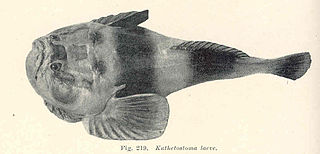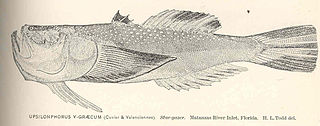Sand stargazers are blennioids; perciform marine fish of the family Dactyloscopidae. Found in temperate to tropical waters of North and South America; some may also inhabit brackish environments. The giant sand stargazer is the largest at 15 cm in length; all other species are under 10 cm.

Astroscopus guttatus is a fish that can reach lengths of 22 inches (56 cm) and is found on the Atlantic shores between the states of North Carolina and New York in the United States. The northern stargazer can be found up to depths of 120 feet (37 m). Stargazers have a flat forehead with a lot of body mass up front near the mouth.

The stargazers are a family, Uranoscopidae, of perciform fish that have eyes on top of their heads. The family includes about 51 species in eight genera, all marine and found worldwide in shallow and deep saltwaters.
Dactyloscopus is a genus of sand stargazers native to the coasts of the Americas.
Dactylagnus is a genus of sand stargazers, found in the eastern central Pacific and western central Atlantic Ocean.
Gillellus is a genus of sand stargazers, found in the eastern central Pacific Ocean and western central Atlantic Ocean.
Heteristius cinctus, the banded stargazer, is a species of sand stargazer native to the Pacific coast of the Americas from Baja California, Mexico to Ecuador where it can be found on sandy bottoms at depths of from 1 to 27 m. It can reach a maximum of 4.5 cm (1.8 in) in total length. This species is currently the only known member of its genus.
Leurochilus acon, the Smoothlip stargazer, is a species of sand stargazer native to the waters around the Caribbean islands of the Bahamas, the Virgin Islands, Antigua and Cuba where it can be found on bottoms consisting of sand, marl and rock at depths from near the surface to 8 metres (26 ft). It can reach a maximum length of 2.9 centimetres (1.1 in) SL. This species is currently the only known member of its genus.
Myxodagnus is a genus of sand stargazers, native to the Pacific and Atlantic coastal waters of the Americas.
Sindoscopus australis is a species of sand stargazer native to the Pacific coast of Chile where it can be found in shallow waters with a sandy substrate. It is currently the only known member of its genus. The generic name is a compound noun the first part of which honours Charles E. Dawson's companion in the field and collector of the type, the Chilean zoologist Gumersindo Revuelta and the second part is Latinised Greek skopos, "watcher".
Dactyloscopus tridigitatus, the sand stargazer, is a species of sand stargazer native to the Atlantic coasts of the Americas from Florida, United States to Brazil as well as in the Caribbean Ocean and the Gulf of Mexico. It is found in sandy areas around reefs at depths of from 0 to 29 metres. It is an ambush predator, burying itself nearly completely in the sand and attacking prey animals that happen by. It can reach a maximum length of 9 centimetres (3.5 in) TL.
Gillellus healae, the masked stargazer, is a species of sand stargazer native to the Atlantic and Gulf coasts of the United States from South Carolina to the Florida Keys as well as around Aruba where it can be found on sandy bottoms at depths of from 21 to 37 metres. It is an ambush predator, burying itself nearly completely in the sand and waiting for prey to happen by. This species can reach a length of 7.5 centimetres (3.0 in) TL. The specific name honours Elizabeth Heal who was Technical Secretary at the Gulf Coast Research Laboratory in Ocean Springs, Mississippi.

The warteye stargazer is a species of sand stargazer native to the Atlantic coast of southwestern Florida, United States, and in the Caribbean Sea from the Bahamas and the coast of Central America to Panama where it can be found in sandy areas on reefs or among rocks. It is an ambush predator, burying itself nearly completely in the sand and waiting for prey items to come along. It can reach a maximum length of 5 cm (2.0 in) TL.
Platygillellus altivelis, the Sailfin stargazer, is a species of sand stargazer native to the Pacific coast of Costa Rica and Panama where it can be found on sandy bottoms at depths of from 3 to 37 metres. It can reach a maximum length of 4.4 centimetres (1.7 in) TL.
Platygillellus brasiliensis, the Brazilian sand stargazer, is a species of sand stargazer native to the Atlantic coast of Brazil where it can be found at depths of from 1 to 6 metres in areas with gravel substrates in which it buries itself almost completely except the eyes and the dorsal finlet. Males of this species can reach a maximum length of 4.1 centimetres (1.6 in) SL, while females can reach a maximum length of 4.0 centimetres (1.6 in) SL.

Platygillellus rubellulus, the Shortfin sand stargazer, is a species of sand stargazer endemic native to the waters around the Galapagos Islands where it prefers to live in areas of fine-grained sediments at depths of from 0 to 20 metres. It can reach a maximum length of 6.2 centimetres (2.4 in) SL.
Platygillellus smithi is a species of sand stargazer native to the waters around the Bahamas where it occurs at depths of from 0 to 9 metres. It can reach a maximum length of 3.4 centimetres (1.3 in) SL. Its specific name honours the collector of the type C. Lavett Smith (1927-2015) who was curator of fishes at the American Museum of Natural History.
Cerdale is a genus of wormfishes native to the western Atlantic Ocean and the eastern Pacific Ocean.

Charles Eric "Chuck" Dawson was a Canadian-American ecologist, ichthyologist, and taxonomist. He held expertise in gobies, flatfishes, and sand stargazers, and was considered "the ultimate authority" on pipefishes in the family Syngnathidae.

The southern stargazer is a species of marine fish in the family Uranoscopidae and genus Astroscopus. They are native to the United States.






